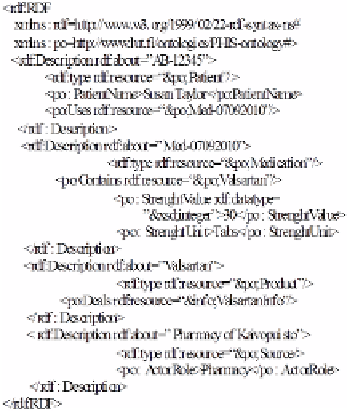Biomedical Engineering Reference
In-Depth Information
3.
The attribute of the XM
4.
The relationships betwe
OWL object properties.
L-schema are transformed into OWL data properties.
een complex elements are be named and transformed
d to
nsformed CDA document in RDF/XML format
Fig. 10.
Tran
Note that as the OWL
formed all complex elemen
have identification have be
lowing complex element:
<Strenght>
<Value>50</Value>
<Unit>milligram</U
</Strenght>
is first transformed into d
connected to the OWL clas
The ontology developed
stylesheet for the CCR doc
ment is an instance of the C
is an instance of the CCR-o
does not support structured attributes we have not tra
nts to classes but rather the complex elements that do
en transformed to a set of properties. For example the
ans-
not
fol-
Unit>
ata properties StrenghtValue and StrenghtUnit, and t
s Medication.
d from the CCR document is called the CCR-ontology. T
cument is then specified in the way that the resulted do
CCR-ontology. So, for example, the document of Figure
ontology, which in turn is a portion of the PHIS-ontology
then
The
ocu-
e 10
y.
8
Conclusions
Monitoring a patient's vital
physician that treats the pati
provides the possibility of a
patient can wear while being
ly the only reliable means
take them directly, or for a p
l signs provides an important source of information to
ient. Nowadays information and communication technol
a new generation of lightweight monitoring systems whic
g at home or while going about their daily business. Form
of such monitoring has been for a medical professiona
patient to be constantly monitored in hospital.
the
ogy
ch a
mer-
al to

Search WWH ::

Custom Search